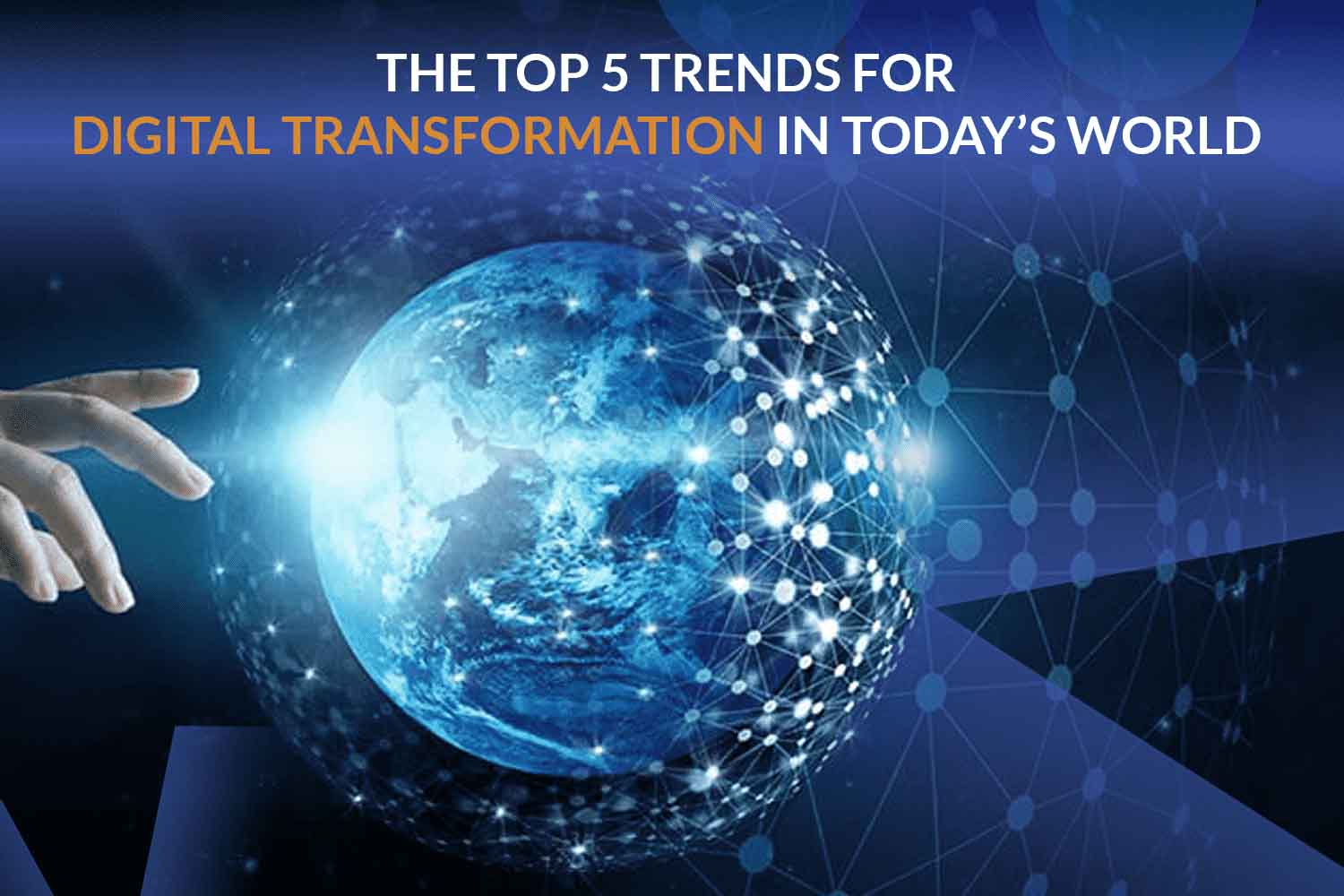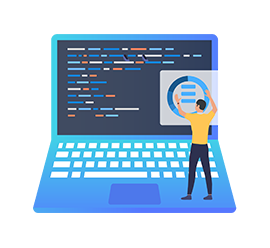June 5, 2020 | Digital Transformation Trends of 2021

It’s a fact that over the past few years, digital transformation has become a catchy term for retaining business in the digital age: it can refer to any method that uses digital technologies to solve for growing business and market demands. Digitalization was being the cause of large-scale transformations across multiple sectors during COVID-19 and was observed in return, bringing opportunities for several companies. Rising in-demand, the IT services sector has emerged over the last two decades from being a provider of solutions and capabilities to partner with clients in driving critical business resolutions and digital transformation.
According to the top executives, Indian IT service provider companies have the advantage to lead the wave of digital transformation across multiple sectors by helping clients in adopting cloud and Digitalization. Approximately (97%) IT professional experts are involved in digital transformation initiatives at their respective organizations, but many struggle to define a clear strategy.
What exactly is driving shared to do to digitally transform in the first place? And what can these trends teach us about how to succeed in today’s fast-growing world? And companies can’t afford to ignore the trend. Firms that adopted digital tech transformation, according to a 2016 Harvard Business School study, Average 55% growth in gross margins over three years, while companies that weren’t sufficiently prepared to adopt digital tech had substantially lower margin growth. Let’s move ahead. A more recent study by The Economist found that 68% of company board members have seen profitability increase over the past three years as a result of digital transformation, while 74% visualize a rise in profits because of their digital strategy. There’s only one constant in business that’s things change as per your strategies. Digital transformation is accelerating those changes in recent years. Businesses need to adopt new ways related to digital transformation. From artificial intelligence (AI) to blockchain, the Internet of Things (IoT) and new digital technologies are having a major impact on businesses – and that impact will only grow in the coming years. Here are the top five trends that businesses will need to be aware of:
IoT as an engine of digital tech growth
According to Report by McKinsey, IoT’s economic impact will increase to $11 trillion a year by 2025. Also, IoT devices are projected to increase to 20-40 billion devices by 2020. IoT’s importance is in the technologies that it contains that makes it work – technologies like advanced analytics, 5G, sensor tech, and among others. IoT is one of the leading technology hubs that is driving the fourth wheel of the Industrial revolution. It comes up with operational visibility to make instantaneous and effective decisions to boost efficiency, saving time and money. IoT helps build smart connected products to provide new functionality, increased reliability, product utilization, etc. Just by example, think of how Ola has transformed the transportation business. With real-time location and traffic data, Ola tells you exactly when you’ll get a ride and when you can arrive at your destination. This is an example of how real-time IoT feedback can improve the customer experience. There are plenty of other examples: automobiles will be connected to cloud analytics that can predict maintenance problems, saving time for drivers. With the flood of data that will be coming from smart devices, companies are working on analytics systems, centered on AI and machine learning – to make sense out of the reams of data that is being recorded, and creating actionable insights out of it. And, with IoT devices deployed everywhere, firms may find it more efficient to process data elsewhere than on the central server – hence the growing development of edge computing systems. While opportunistic deployments of IoT are beginning to generate awareness, the real potential of this technology will only be realized when executives embark on a more systematic assessment of the economic and strategic value of this technology.
AI and Machine Learning takes center stage and become force multipliers for data analytics:
“AI is one of the technologies that will help standardize the digital transformation market and turn the wildly loose use of the term ‘digital’ into tangible business results,” the TBR analysts Digital Transformation trends 2021 Insights report. Even once all that data is wrangled, making sense of it at scale in a usable way will require some help from our machine friends. Digital experts say AI will be the key to delivering business outcomes with digital transformation.
Machine learning and AI can also be leveraged within modern data architecture paradigms to mitigate the data governance problem and cleansing through to extraction in an analytics-ready format. Machine-learning algorithms have also matured and expanded over the past year. IT leaders should incorporate them into their business-driven data analytics strategy to more quickly and effectively synthesize and present insights gleaned from the massive amounts of enterprise data. If you are going to invest in analytics, you also need to invest in AI and machine learning to be able to navigate the seas of information and data you aim for good use. Speed and scale speak to the advantage of automating the analysis of massive data sets to the task. Thanks to AI and machine learning, complex data sets can now be analyzed in a fraction of the time it used to take just two years ago. This is not because computers have become faster rather because AI and machine learning algorithms have gotten extremely good at data analysis due to that analysis can easily be scaled in the cloud. Automating the analysis of data sets will bring significant gains in speed and scale alike. AI and machine learning will permit us to analyze complex data sets in a fraction of the time it used to take just two years ago. The addition of AI and machine learning to analytics tools is also more convenient since they have made the tools more intuitive and reliable.
Not surprisingly then, some studies anticipate a 95% growth projection in the adoption of AI in the next two years. The most common use cases of AI include machine learning, virtual agents and basic task automation, and in 2020, the number of customer service operations that will use virtual customer assistants will make up 25% of the total.
Blockchain
Blockchain was a bust for 2019. But coming into 2021, we can see some meaningful use cases for blockchain beyond cryptocurrency. We know Amazon Web Services is already working hard, and tons of other global leaders are included. What’s more, they’re putting together real use cases to go along with the technology, especially in terms of intellectual property, royalties, etc. I believe those things will take off in the coming years. It could be the beginning of the rise of Blockchain: not only payments and cryptocurrencies, but it can also be used in food security, in real estate or wealth management, or even in intellectual property or royalties. It’s an interesting perspective, so much so that some companies, including Amazon Web Services, are already working to make it as concrete as possible. Broderson notes that according to the Deloitte 2019 Global Blockchain Survey, they’re expecting common barriers to blockchain adoption such as security threats, implementation headaches, or regulatory issues to decrease significantly.
Unlocking and analyzing data for data-driven business
At the best-run companies, IT teams are more invested in sharing data insights across the business. Once that data is unlocked, companies can put it to work to improve customer experiences, streamline operations, and quickly launch new products and services. If your company isn’t ready to unlock the potential of data and invest in analytics in 2020, you might be out of business by 2021. The valuable insights to be harvested from the customer data have outweighed the “following your gut feeling” way of running a business a long time ago. However, unlocking and analyzing the increasing volume, velocity, and variety of data is not an easy task. Gathering mobile data, sensor data, voice data, etc. is not an answer without an insight engine to organise and interpret it. New regulations like the General Data Protection Regulation (GDPR) also mean that over-preservation of data that might cause risk in data privacy and compliance risk which means without planning and management never store data. Lane Airbus provides its employees on the shop floor with real-time data so they can make fast, accurate operational decisions. In addition to providing seamless consumer experiences, the most successful organizations are unlocking their data to innovate at speed. Failure to unlock data has direct consequences for the business, with 83% of IT decision-makers reporting that data silos create business challenges within their organizations.
Digital Transformation Aims at Modernizing Touchpoints to Enhance Customer Experiences
The modern customer journey often begins online, with customers researching, reading reviews, price-comparing, and looking for active customer services before making any purchase decisions. The ability to quickly respond and address customers’ concerns with modern communications capabilities will drive greater customer loyalty, and increase satisfaction. These digital technology innovations will certainly play a vital role to design the superior customer experience, and determine the impact of CX and optimize efforts. Customer journey maps should be designed in such a way that it provides clarity, and very quickly, marketers can see what they should put their focus on. It should enable marketers to turn the massive and fuzzy that is customer experience strategy into something actionable very quickly.
Organizations need to solve for increasing pressure on IT to open up bandwidth for delivering connected, personalized experiences for all of their consumers — from customers to partners to employees to developers. Ensuring an excellent consumer experience remains the constant challenge that companies will face in the new decade, which will directly impact business performance. Delivering a personalized and reliable customer experience, according to 93% of business executives, will be critical to the overall business performance. Also, consumer expectations are rising rapidly. Users are focusing on products and services that meet their needs and expectations through smart, immediate, and easy-to-use procedures, with no friction between different channels and no geographical constraints.
Over the years, the top drivers for advanced digital transformation efforts have consistently revolved around two things:
- modernizing technologies across the enterprise
- investing in modern customer experiences.
Now, competing for new market opportunities also becomes paramount. More than half of the companies we surveyed reported that they are investing in growth opportunities in new markets, making it the leading driver for digital transformation efforts. Studying evolving customer behaviours and preferences rank second at 46%. The third leading driver is increased competitive pressure (41%).
Customer touch points must be updated continuously as fractured, dated, or unintuitive ones impair the customer experience. As such, CX-focused efforts represent a significant cluster of short and long-term digital transformation priorities to enable a more customer-centric and real-time infrastructure.
In Closing
While older, more mature foundational technologies will continue to find themselves at the center of most digital transformation initiatives, especially in the enterprise, I believe that these ten specific trends will both dominate digital transformation discussions and inform the trajectory of successful digital transformation trends in 2021. If you were looking for a cheat-sheet of the ten most critical business trends to prepare for 2021, this is it.

 .Net
.Net Vue.js
Vue.js Twilio
Twilio Postgre
SQL
Postgre
SQL PHP
PHP React.js
React.js Bootstarp
Bootstarp MySql
MySql Laravel
Laravel Woo
Commerce
Woo
Commerce Firebase
Firebase SQL
Server
SQL
Server Angular
Angular Python
Python ChatBot
ChatBot Wordpress
Wordpress Node.js
Node.js Full
Stack
Full
Stack MongoDB
MongoDB Drupal
Drupal





















